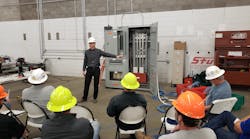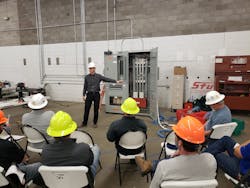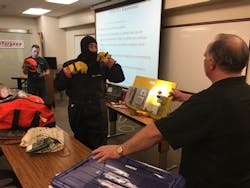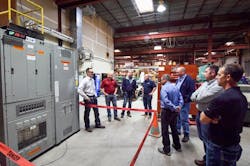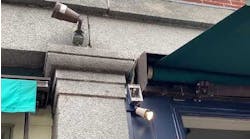It’s one of the top safety concerns for electrical contractors: knowing whether, when, and how to deploy staff to work with or near energized electrical equipment.
Repair, installation startup, commissioning, and maintenance tasks that can or must be performed with circuits in a known or potentially energized state come with the territory many contractors occupy; some routinely do it, others occasionally do it. All, however, are expected to understand how to mitigate potentially fatal shock and arc flash risk by following established, detailed, and exacting safety procedures and guidelines articulated in NFPA guidelines and OSHA workplace safety rules. Moreover, with a proliferation of mission-critical and health care client environments that prioritize 24-7/365 uptime, pressure on contractors or in-house maintenance teams to avoid or limit power shutdowns — and perform a broader scope of work in electrically live settings — might only be building.
Whether working “hot” in some manner is more commonplace or is largely relegated to special situations, there are signs the trade may be stepping up efforts to more closely examine and better understand this practice and increase the margin of safety for those who carry it out.
Leading by example
Exhibit A might be what Sturgeon Electric Company, Inc., Henderson, Colo., has been refining for the last several years and recently showcased at the National Electrical Contractors Association (NECA) virtual safety conference. It runs a program that periodically puts a select group of employees through an intensive 12-hour, in-house-developed course of learning on how to approach and perform work in energized settings. The emphasis is on safety: understanding and following protocols that reduce the chance of someone getting hurt while performing tasks that can carry high risk of serious injury or death. Those include working de-energized whenever possible, a priority approach that adheres to OSHA rules that seek to limit worker exposure to danger.
Billed as an electrical energized work competency and authorization course, the Sturgeon program consists of three modules, each building on the other, designed to fully train, authorize, and designate ― to the company’s standards ― participants to perform energized work. Each class of typically no more than 20 employees, who must be first aid trained and either licensed journeymen or apprentices with more than 6,000 hours to participate, is filled through nominations of the operations manager or area superintendent.
Spread over several weeks of each quarter’s final month, the course, conducted by a safety manager as well as district leadership, first reviews key considerations in preparing for and performing energized work. The initial chalk talk module covers basics such as arc flash/electric shock hazards and awareness; approach boundaries; energized work permitting; lock-out/tag-out procedures; writing of methods of procedure; NFPA 70E requirements for workplace electrical safety; daily safety briefings; and emergency action plans. The second four hours are devoted to applying what was taught, with participants tasked with demonstrating competency in areas like PPE selection and donning/doffing; completing an energized electrical work permit (EEWP); voltage meter selection and use; and techniques for releasing electrical contact victims. The final training phase exposes PPE-outfitted participants to proctored virtual work, including putting them in front of actual, but de-energized switchgear wired with alarms and buzzers to safely show consequences of specific manipulations.
Upon completion, employees who pass become authorized to perform energized work and constitute the only group of Sturgeon employees permitted to do so. They subsequently continue to learn the finer points of the work through additional education and on-the-job learning, advancing to become go-to experts in safely handling any energized work the company may be tasked to perform.
A sound investment
Though a costly undertaking factoring in regular workday scheduling, training materials and supplies, and worker downtime, Sturgeon leadership says the program is warranted because energized work is laden with big potential costs — both human and financial. It represents an investment with significant payback potential, given the incidence of energized work ― broadly defined to include many routine inspection and assessment activities ― and the significant damage that mishaps can inflict. Working to better ensure that all energized work scenarios are fully vetted and performed only by highly trained and trusted workers is the best way to reduce risk, given issues like workforce turnover, evolving understanding of best practices, and shifting client needs and perceptions, they say.
Don Egan, president of Sturgeon’s commercial and industrial operations, says the need for a laser-focused training program became apparent as the company grew, and worries mounted about whether worker safety might be inadvertently compromised as a consequence. Of all the worker safety areas, energized work was identified as the one with the most glaring need for attention.
“When we were a smaller contractor, we operated in a more controlled environment where we all maybe knew one another better and knew who in the company had the capability to do energized work,” says Egan, noting Sturgeon has grown rapidly in the last half-decade. “Growth has put more stress on our leadership and field management operations, and there’s also the reality that we have a very different workforce than we did 20 years ago. Teaching younger craft labor how to use tools and to think for themselves has grown more difficult. Add that all up, and we took a step back and said, ‘We’re putting our employees at risk, and we’re also sometimes working with customers who may not be all that aware of what they’re asking us to do.’”
While the course has a heavy focus on following procedures to perform energized work safely, it also trains workers in the process of determining, in concert with the client, whether de-energized options are available in different scenarios. Up front, participants are instructed that workplace safety rules dictate energized work should be a last resort — that it should only be done after exhaustive analysis deems de-energized work “infeasible” because it would compound or introduce other safety hazards or cause costly, unavoidable disruptions.
“Our first line of defense is getting the client to shut the power off if it’s feasible,” Egan says. “We’re working to try to educate people now about the different ways to perform tasks safely, de-energized, and part of that is putting the onus back on the customer, having them more involved in the process and getting them to understand and acknowledge the risk. In many instances, the owner agrees there’s a way around that and they end up not authorizing it.”
Addressing misconceptions
But potential energized work scenarios still arise plenty often enough to warrant the program, says Bryce Perkins, Sturgeon district manager. It’s justified, he explains, because misunderstanding of what qualifies as energized work is all too prevalent. Too few workers, he asserts, come to the company adequately trained in the nuances of energized work, either from direct experience or specific instruction. They may lack the understanding, for example, that much routine evaluation/inspection/assessment work qualifies as energized work, even though it doesn’t involve “manipulation” tasks that bring workers into intentional, planned contact with energized parts, he says. By training and authorizing only a select few for energized work, the company minimizes worries about unqualified workers finding themselves in energized work situations.
“Non-manipulative work is often misunderstood and not properly categorized as a hazard,” Perkins says. “It may not be energized activity, per se, but hazards still exist. Performing certain functions, like IR scanning where you do live load inspections by opening up a cabinet, exposes workers. Awareness and education are needed to evaluate those situations and apply the right protective measures if something goes wrong.” Aiming to keep about a quarter of its Colorado workforce trained and authorized, Sturgeon executives are confident that decisions routinely made in the field about approving and performing energized work are in competent hands. With extensively trained and authorized workers, Perkins says, the company is better-positioned than average to factor safety into work with clients, notably data centers and hospitals that present the most energized work issues. He maintains that its in-house program ensures employees working in the most potentially dangerous settings meet the spirit and letter of the NFPA 70E definition of a “qualified person” for electrical work purposes, someone with not only skills and knowledge to work around electrical equipment, but also one who has “received specific safety training on the hazards involved.”
Licensing, Perkins says, only gets an electrician part of the way to being able to handle the most potentially dangerous situations. “To rely on that as a qualification for anyone jumping into this type of work, we said ‘no,’ that we needed to take it a few steps further.”
Critical acclaim
As Sturgeon’s program has matured, it has drawn the attention of other contractors and safety watchdogs. It came up in discussions at a 2019 NECA safety professionals conference, which led the company to invite NECA officials to visit and learn more about the program. That led to NECA incorporating a continuing education breakout class on Sturgeon’s program, led by regional safety manager, Zachary Valdez, into this year’s virtual safety conference.
OSHA, too, has weighed in on the program in the course of closely observing Sturgeon workplace safety practices monitored through the agency’s Voluntary Protection Program (VPP). According to Perkins, the VPP evaluation team, in a recent formal Mobile Workforce Participation Evaluation Report on Sturgeon, classified the program as one of several company “areas of excellence,” stating, “permitting, training, simulators, and stop work authority all work together to contribute to an exceptionally strong program in this area.”
NECA’s Safety Director Wes Wheeler, who traveled to Sturgeon headquarters to assess the program alongside association president, Larry Beltramo, says the company’s stance on not accepting any risk recognizes the problems that can easily arise when pressure to do energized work meets workers ill-equipped to do the job.
“Contractors can feel the pressure of client needs related to production and service interruptions, and may choose to take risks and shortcuts to increase productivity or preserve client relationships,” says Wheeler, adding that mishaps can have far-reaching downside consequences. “The truth is that many (contractors and workers) feel they’re more qualified and experienced than they actually are. This is the dangerous reality.”
Wheeler senses the contractor community is becoming more acutely aware of the dangers and the need to better educate and train workers. Few, however, are copying Sturgeon’s approach, which stands out for its extensive hands-on component, especially those that are smaller and lack the resources. Their size, smaller employee base, and lower employee turnover, however, may lessen the need for such a thorough, ongoing qualification program.
Replicating the program
Elements of the Sturgeon approach could be integrated into programs offered through the NECA-IBEW electrical training alliance, says Justin Thayer, director of safety for NECA’s Puget Sound chapter. Thayer has studied Sturgeon’s program and sees some potential for training programs offered at the joint training center in Portland, Ore., to incorporate a hands-on, interactive approach to energized work training. Thayer also hoped to discuss the program with safety managers at a Sturgeon branch in Auburn, Wash., which is poised to begin replicating the course offered in Sturgeon’s Colorado division.
Barry Moreland, safety director at the Portland training center, likes the general idea of offering more immersive and focused energized work training but hesitates to endorse the center going as far as formally qualifying or authorizing trainees to perform the work, saying that responsibility must rest with employers.
“We could take on some risk offering that simulated environment and having employers then assume they’ve been trained on everything they need to know,” Moreland says.
Shouldering that entire responsibility is the essence of Sturgeon’s approach, but it’s far from the only model for navigating energized work’s challenges. Other contractors have done a “180,” taking the stance that energized work is mostly off the table.
Marty Rouse, vice president of safety at Rosendin Electric, San Jose, Calif., says that’s been the company’s standard policy for several years, a stance that has allowed it to convince clients that safer, workable alternatives exist in most cases thanks in part to emerging technologies. He lauds Sturgeon for its effort to ensure that energized work, when unavoidable, is performed only by experts, but says the future lies in contractors coming to the realization that they can and should avoid it whenever possible.
That might be a tall order, however, in the view of Terry Becker, owner of Canada-based TW Becker Electrical Safety Consulting, Inc. As mission-critical operations proliferate and the need for maintenance and troubleshooting activities grows, energized work will be a front-and-center issue that won’t produce easy answers or ready consensus, he says. Leading companies in that space have made steady progress in curtailing energized work or making it safer through workarounds, but contractors must continue to be ready to perform energized work and perform it safely.
“Energized work needs to be done with risk managed more than it ever has in the past, because it’s going to grow,” Becker says. “So, I’m hoping that more companies will do what Sturgeon has done, and put their people through something similar. Probably less than one percent of contractors are doing what they’re doing.”
Zind is a freelance writer based in Lees Summit, Mo. He can be reached at [email protected].
